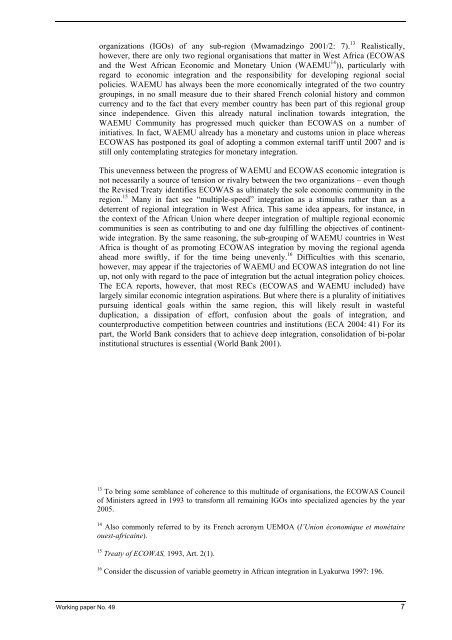The Social Dimension of Regional Integration in ECOWAS
The Social Dimension of Regional Integration in ECOWAS
The Social Dimension of Regional Integration in ECOWAS
Create successful ePaper yourself
Turn your PDF publications into a flip-book with our unique Google optimized e-Paper software.
organizations (IGOs) <strong>of</strong> any sub-region (Mwamadz<strong>in</strong>go 2001/2: 7). 13 Realistically,<br />
however, there are only two regional organisations that matter <strong>in</strong> West Africa (<strong>ECOWAS</strong><br />
and the West African Economic and Monetary Union (WAEMU 14 )), particularly with<br />
regard to economic <strong>in</strong>tegration and the responsibility for develop<strong>in</strong>g regional social<br />
policies. WAEMU has always been the more economically <strong>in</strong>tegrated <strong>of</strong> the two country<br />
group<strong>in</strong>gs, <strong>in</strong> no small measure due to their shared French colonial history and common<br />
currency and to the fact that every member country has been part <strong>of</strong> this regional group<br />
s<strong>in</strong>ce <strong>in</strong>dependence. Given this already natural <strong>in</strong>cl<strong>in</strong>ation towards <strong>in</strong>tegration, the<br />
WAEMU Community has progressed much quicker than <strong>ECOWAS</strong> on a number <strong>of</strong><br />
<strong>in</strong>itiatives. In fact, WAEMU already has a monetary and customs union <strong>in</strong> place whereas<br />
<strong>ECOWAS</strong> has postponed its goal <strong>of</strong> adopt<strong>in</strong>g a common external tariff until 2007 and is<br />
still only contemplat<strong>in</strong>g strategies for monetary <strong>in</strong>tegration.<br />
This unevenness between the progress <strong>of</strong> WAEMU and <strong>ECOWAS</strong> economic <strong>in</strong>tegration is<br />
not necessarily a source <strong>of</strong> tension or rivalry between the two organizations – even though<br />
the Revised Treaty identifies <strong>ECOWAS</strong> as ultimately the sole economic community <strong>in</strong> the<br />
region. 15 Many <strong>in</strong> fact see “multiple-speed” <strong>in</strong>tegration as a stimulus rather than as a<br />
deterrent <strong>of</strong> regional <strong>in</strong>tegration <strong>in</strong> West Africa. This same idea appears, for <strong>in</strong>stance, <strong>in</strong><br />
the context <strong>of</strong> the African Union where deeper <strong>in</strong>tegration <strong>of</strong> multiple regional economic<br />
communities is seen as contribut<strong>in</strong>g to and one day fulfill<strong>in</strong>g the objectives <strong>of</strong> cont<strong>in</strong>entwide<br />
<strong>in</strong>tegration. By the same reason<strong>in</strong>g, the sub-group<strong>in</strong>g <strong>of</strong> WAEMU countries <strong>in</strong> West<br />
Africa is thought <strong>of</strong> as promot<strong>in</strong>g <strong>ECOWAS</strong> <strong>in</strong>tegration by mov<strong>in</strong>g the regional agenda<br />
ahead more swiftly, if for the time be<strong>in</strong>g unevenly. 16 Difficulties with this scenario,<br />
however, may appear if the trajectories <strong>of</strong> WAEMU and <strong>ECOWAS</strong> <strong>in</strong>tegration do not l<strong>in</strong>e<br />
up, not only with regard to the pace <strong>of</strong> <strong>in</strong>tegration but the actual <strong>in</strong>tegration policy choices.<br />
<strong>The</strong> ECA reports, however, that most RECs (<strong>ECOWAS</strong> and WAEMU <strong>in</strong>cluded) have<br />
largely similar economic <strong>in</strong>tegration aspirations. But where there is a plurality <strong>of</strong> <strong>in</strong>itiatives<br />
pursu<strong>in</strong>g identical goals with<strong>in</strong> the same region, this will likely result <strong>in</strong> wasteful<br />
duplication, a dissipation <strong>of</strong> effort, confusion about the goals <strong>of</strong> <strong>in</strong>tegration, and<br />
counterproductive competition between countries and <strong>in</strong>stitutions (ECA 2004: 41) For its<br />
part, the World Bank considers that to achieve deep <strong>in</strong>tegration, consolidation <strong>of</strong> bi-polar<br />
<strong>in</strong>stitutional structures is essential (World Bank 2001).<br />
13 To br<strong>in</strong>g some semblance <strong>of</strong> coherence to this multitude <strong>of</strong> organisations, the <strong>ECOWAS</strong> Council<br />
<strong>of</strong> M<strong>in</strong>isters agreed <strong>in</strong> 1993 to transform all rema<strong>in</strong><strong>in</strong>g IGOs <strong>in</strong>to specialized agencies by the year<br />
2005.<br />
14<br />
Also commonly referred to by its French acronym UEMOA (l’Union économique et monétaire<br />
ouest-africa<strong>in</strong>e).<br />
15 Treaty <strong>of</strong> <strong>ECOWAS</strong>, 1993, Art. 2(1).<br />
16 Consider the discussion <strong>of</strong> variable geometry <strong>in</strong> African <strong>in</strong>tegration <strong>in</strong> Lyakurwa 1997: 196.<br />
Work<strong>in</strong>g paper No. 49 7

















